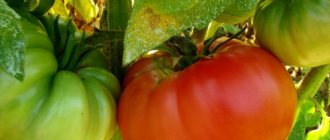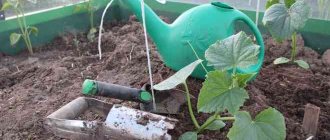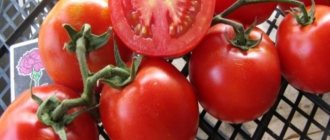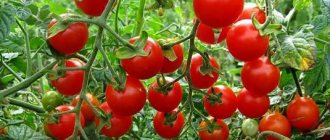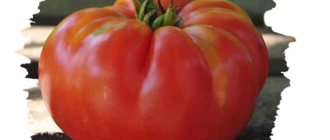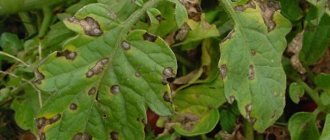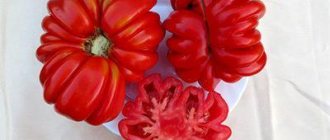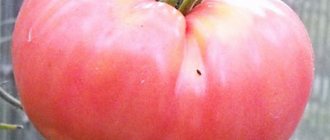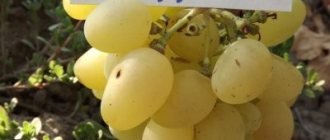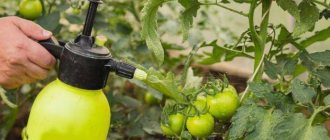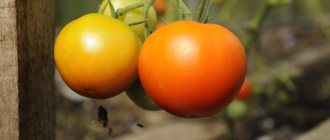Recently, pink and yellow tomatoes have become very popular. The former have a rich sweet taste, which is ideal for preparing salads, while the latter are non-allergenic and contain substances beneficial to the body.
Thanks to modern breeding, the agronomist was able to develop several varieties that combine the best qualities of yellow and red tomatoes. These include the tomato Mystery of Nature. Its fruits are yellow-pink in color and have a wonderful taste. How to grow such tomatoes on your plot, and what nuances of their agricultural technology should be taken into account - read on.
General description of the variety
Tomato Mystery of Nature is a variety bred by domestic breeders . It is produced by, whose agronomists are considered the creators of this tomato.
The Mystery of Nature was included in the Russian state register in 2008.
Advice! Since the Mystery of Nature is a varietal tomato, the seeds obtained from its fruits are used for planting.
Distinctive features
The fruits of the Mystery of Nature tomatoes look very unusual . They combine two colors at once - yellow and pink. Not only the shell of tomatoes, but their flesh is covered with multi-colored spots.
Tomatoes of this variety are interesting not only for their color, but also for their size . On average, one berry weighs 300-500 g. Reviews from gardeners indicate that the record weight of the fruit reaches 1 kg.
The mystery of nature combines all the advantages of yellow-fruited and pink-fruited tomatoes . They have a sweet taste and firm but juicy flesh. They contain beta-carotene, which helps improve the functioning of the thyroid gland, normalize hormonal levels, sharpen vision and increase the body's defenses. Tomatoes of this color and composition are much less likely to cause an allergic reaction.
The variety is considered a salad variety . Its fruits are not suitable for canning in their entirety. They make juices and sauces. When cooked, tomatoes lose most of their beneficial properties.
Despite their exotic appearance, tomatoes are cold-resistant . This makes it possible to grow them outdoors in regions with a temperate climate.
One of the negative features of the variety is the lack of immunity to tomato diseases. Therefore, it needs careful preventive treatment.
Main characteristics of Mysteries of Nature
The Mystery of Nature tomato is an exotic variety whose pods not only look interesting , but also have a pronounced tomato taste. Its cultivation is complicated by low immunity, but its other parameters will impress novice gardeners.
Characteristics and description of the variety:
| Parameter | Indicators |
| Bush type | The Mystery of Nature bush grows throughout the growing season and is classified as indeterminate. The plant reaches a height of 1.5-2 m. Its stems are strong and powerful. The bushes are covered with an average amount of greenery. The leaves are medium sized, simple, dark green. The inflorescences are simple. The first is formed in the axil of 8-9 leaves, the next ones every 3 leaves. |
| Growing method | Tomatoes are resistant to temperature changes. They grow both in open and protected ground. |
| Productivity | High. 7 kg of fruits are harvested from 1 bush per season, subject to proper agricultural technology. From 1 sq. m get up to 20 kg of harvest. |
| Fruit | Big size. One berry weighs on average from 300 to 500 g. There are specimens weighing up to 1 kg. The skin color is yellow, with a pink tip. The inside is yellow-pink, with more pink areas. There is no green spot at the base, but lighter spots may be present. The pulp is dense but juicy. The berries taste sweet, with a slight sourness and tomato aroma. The shape is round, flattened on both sides. There is pronounced ribbing at the base. There are many small chambers in tomatoes, more than 8. They contain a small amount of seeds. |
| Transportability | Low. Tomatoes have a delicate skin that does not protect them well from mechanical damage. They are not suitable for transport over long distances and can be stored for no more than 2 weeks outside the refrigerator. |
| Ripening time | Mid-early tomato. The fruits ripen 105-110 days after sowing the seeds. |
| Disease resistance | Immunity to tomato diseases is low. |
THE MOST DELICIOUS TOMATO OF THIS SEASON IS A MYSTERY OF NATURE! Olga Chernova.
Advantages and disadvantages
The fruits of the Mystery of Nature tomatoes not only have a distinct taste, they are classified as dietary products due to their low content of purine acids. This feature is typical for yellow tomato varieties.
Up to eight chambers are formed inside the fruit, which contain small, barely noticeable seeds.
pros
- high productivity;
- cold resistance;
- good taste;
- unpretentiousness.
- high fruit set.
Minuses
- instability to diseases;
- the need for garter and formation of shoots;
- the brushes break off under the weight of the fruit.
- impossibility of transportation and long-term storage.
Growing seedlings
Tomato seedlings begin to be grown 2 months before planting in open ground . If you plan to plant plants in open ground, then the seeds begin to be sown at the end of February in the southern regions, in the second half of March in the central zone, and at the beginning of April in the northern part of Russia. To plant tomatoes in a greenhouse, planting material is sown two weeks earlier.
Before sowing tomato seeds, experienced gardeners advise familiarizing yourself with the indicators of the lunar calendar. It is believed that tomatoes planted on the correct lunar day grow healthier and stronger.
Other interesting tomato varieties:
Hybrid tomato "Ivan da Marya"
Growing the “Tsar’s Gift” tomato
Full review of the Black Heart of Breda tomato
Seed preparation
Before purchasing seeds, you need to check their expiration dates . To ensure the germination of planting material, it is soaked in salted water. Floated specimens are not able to germinate. Those seeds that have sunk to the bottom are washed and used for planting.
Tomatoes are a mystery of nature and have low immunity to tomato diseases . Therefore, their seeds are treated in the factory. The manufacturer indicates information about seed treatment on the packaging, and colors the planting material in light green or orange.
If planting material taken from independently grown tomatoes is used , then it is processed at home. To do this, it is soaked in a solution of potassium permanganate for half an hour or in hydrogen peroxide for a quarter of an hour. Then the planting material is washed.
Soaking seeds in a growth stimulator will not only speed up their germination, but also increase resistance to temperature changes and additionally protect against diseases. There are several popular means for stimulating tomato seeds :
- "Epin";
- "Sodium humate";
- honey water;
- soda solution.
Pieces of gauze are moistened in the selected composition . Planting material is wrapped in them. The fabric with the seeds is placed in a saucer, which is covered with film and placed in a warm place.
Selection of containers and soil
When growing seeds in the usual way, large containers are used . Wooden boxes, plastic trays, cake packaging, trimmed 6 liter bottles and other available materials are suitable for these purposes.
Later, the seedlings are planted into individual containers . They use peat and plastic pots, disposable tableware and cut-off bottles.
Advice! Peat pots are considered the most convenient for growing tomatoes. When picking plants to a permanent place, they do not need to be removed from such containers.
Containers for planting plants need to be treated . To do this, they are soaked for half an hour in a strong solution of potassium permanganate.
For seedlings, take light and nutritious soil . Experienced gardeners advise using soil from a greenhouse as a basis. This will speed up the survival of tomatoes after picking them to a permanent place.
Garden soil is mixed with humus and peat in equal proportions . If the acidity of the resulting soil is high, then ash is added to it (1 tbsp per 1 bucket). The soil for tomatoes is also treated. To do this, it is poured with a strong solution of potassium permanganate or calcined in the oven.
Sowing planting material
Soil is poured into the container for sowing seeds so that 3 cm remains to the edge . The soil is moistened abundantly with warm, settled water.
The seeds are placed in boxes in rows at a distance of 2 cm from each other. There should be a gap of 3 cm between the lines of planting material.
The seeds are covered with a centimeter layer of soil on top . The containers are covered with film and placed in a warm place, with a temperature not lower than +23°C.
Seedling care
In order to grow healthy seedlings that can quickly adapt to new conditions after planting in a permanent place, you need to follow all the rules of care when growing them :
- Tomatoes do not need sunlight until the first shoots appear When the plants sprout, they need to be placed in a well-lit place. In spring, they may lack natural light. The lack of light is compensated with the help of fluorescent lamps.
- After the first tomato sprouts appear , the film is not removed for a week. Then the improvised greenhouse is dismantled.
- You need to water the seedlings so that the water does not reach the above-ground part of the plants. Only warm, settled water is used for these purposes.
- When the first true leaves appear on the tomatoes , they are picked into individual containers. The seedlings are carefully removed from the box along with a lump of earth. It is important not to damage their root system.
- Seedlings are fed three times . The first is 14 days after the pick. The second - 2 weeks after the previous feeding. The last one is 3 days before landing at a permanent place. Complex fertilizers, growth stimulants and vermicompost are used. For one plant, take half the portion indicated on the package. Fertilizer for the last feeding should contain phosphorus.
- 14 days before planting tomatoes in the ground, they begin to harden. The plants are taken outside, gradually increasing the time they spend in the fresh air.
History of tomato breeding
According to official data, this variety was bred in 2008 in Novosibirsk. It was then that this species was included in the State Register. The originator is . The following breeders worked on the creation of the variety: V. N. Dederko, O. N. Postnikova and S. I. Ugarova.
Their goal was to create a large-fruited variety that could combine the best qualities of pink and yellow varieties. And at the same time, the tomato must maintain productivity even under unfavorable weather conditions. And judging by the characteristics of this variety, they succeeded.
Agricultural technology Mysteries of nature
The mystery of nature is planted in a permanent place when the soil warms up . The outside temperature should not be below +10°C. Otherwise, the plants will die.
Tomatoes are planted in open ground:
- in the south of the country - in the second ten days of April;
- in regions with a temperate climate - in March;
- in the northern regions - in early June.
Tomatoes are planted in the greenhouse 2 weeks earlier . Before picking, the seedlings are watered and fed.
Productivity
The formation of flowers, setting and ripening of fruits occurs as the bush develops. Yield parameters depend on the length of the growing season.
With proper care, tomatoes give a good harvest
In the middle zone, it can be extended by growing vegetables in greenhouses. It is this method that helps to get the most abundant harvest - it is 12-16 kg per 1 square meter.
Tomatoes of the Mystery of Nature variety have a large number of advantages. They have excellent taste and ripen very early. To get a bountiful harvest, it is necessary to provide the plant with complete and high-quality care. Pest and disease control is of no small importance.
Growing tomatoes in greenhouses and open ground
When growing tomatoes in protected soil, you need to take into account that pathogens spread faster indoors. Therefore, greenhouses need to be ventilated regularly. This will create the optimal moisture level for the tomatoes.
In a greenhouse, it is more difficult for tomatoes to self-pollinate . Therefore, in such conditions, you need to shake the bushes more often. Another option is to install a fan in the room. Before picking tomatoes into the greenhouse, the walls of the room are treated with copper sulfate. Pathogens remain on them.
When growing Mysteries of Nature in open ground , the first two weeks after picking, the tomatoes are covered with film at night. This will help protect them from frost.
Diseases and pests
Tomato diseases can destroy the entire crop, so disease control must begin before planting seedlings. Let's look at the most common of them for greenhouse tomatoes, which include “The Mystery of Nature.”
Late blight - at the beginning of the disease, the leaves turn brown, then the fruits turn brown. The disease is caused by large temperature changes and excessive humidity. Spraying with copper-containing preparations helps to cope with the disease in the early stages.
Tomato blossom end rot . It is characterized by depressed spots on green fruits. Excess nitrogen, lack of calcium or lack of moisture are the main causes. Regular watering and treatment with saltpeter solution helps to cope with the disease.
For leaf mold, the main symptom is the appearance of brownish-brown spots that are covered with a gray coating. The use of bacterial preparations and treatment of the plant with a solution of copper oxychloride will help cope with the disease.
Tomato mosaic is a very unpleasant disease. The distinctive features of the mosaic are colored spots that appear first on the leaves and then on the fruits. Prevention is done by washing the seeds in a 1% solution of potassium permanganate. Affected plants are burned.
Another disease is fruit cracking. But its cause is not mushrooms or viruses, but abundant watering during drought. When a large amount of water immediately enters the stem, and then into the fruit itself, its delicate skin cannot withstand the pressure and cracks. It is not difficult to cope with diseases; the most important thing is to notice them in time and diagnose them correctly.
In conclusion, I would like to wish you success in growing an excellent harvest of tomatoes, including the “Mystery of Nature” !
Farmer reviews
Reviews about the Mystery of Nature are contradictory. All farmers note their excellent taste and beautiful fruits, as in the photo, but complain that they are often affected by diseases.
Vadim Kirechenko, Belgorod: “I have already grown Mystery of Nature tomatoes twice. The first one is in open ground. The tomatoes became infected with late blight and could not be saved. Last year I planted a few more bushes in the greenhouse. Every 2 weeks he carried out preventive treatments. The harvest turned out great, the fruits are large, tasty and beautiful.”
Kiseleva Elizaveta, Zelenograd: “Last year I planted the Mystery of Nature. Formed bushes into 1 stem. A couple of bushes had to be thrown out due to fusarium, but the rest were saved. I'm happy with the harvest. The fruits really turn out to be very large, two-colored. The first tomatoes weighed almost a kilogram.”
The main thing about tomato
A powerful medium-branched bush is formed into 1-2 stems. Pruning and tying the plant to a support are required. The leaves are light green. The productivity of the tomato “Mystery of Nature” is up to 17 kg per sq.m.
Tomatoes ripen gradually, 5-6 fruits are formed in each cluster after 8 leaves, and have the following features:
- The shape is flat-round.
- The color of ripe fruits is yellowish-pink; when cut, it is yellow with crimson splashes.
- Weight ranges from 200 to 700g.
- The pulp is juicy and sweet, the skin is thin.
- Used in cooking for preparing salads, various dishes, sauces and lecho.
- They have dietary properties.
Pros and cons of the variety
- This variety has the following advantages:
- good sweet and sour taste;
- resistance to temperature changes and changes in moisture levels;
- the pulp is very juicy;
- good yield indicators;
- interesting color.
- The disadvantages of the variety are:
- difficulty in manual harvesting due to the thick, durable stalk;
- the need for additional garters due to the combination of tall stems and heavy fruits;
- It is difficult to transport and preserve tomatoes intact, since the fruits have thin skin.
Planting and care
Seeds are planted for seedlings approximately 55-60 days before planting in the garden (mid-March - mid-April). Before sowing, they must be disinfected in a solution of potassium permanganate. After this procedure, they can be planted in the soil.
After emergence and then every 2 weeks, it is recommended to fertilize the seedlings, since the variety is very fond of fertilizing and growth stimulants.
Since the tomato Mystery of Nature (photo attached) is a tall plant, per 1 sq. m. you can place no more than 3 bushes. As it grows, it is necessary to tie up the main stem and clusters with fruits, since the branches can break off under the weight of large fruits.
Watering tomatoes of the described variety should be done once or twice a week. Also, fertilizing is carried out with various mineral and organic fertilizers, treatments with drugs against pests and diseases, stepsons are removed from the bushes as they appear, and inflorescences are pinched.
Since the fruits are very large and the skin is thin, it is advisable to use a knife or garden shears when harvesting so as not to damage the ripe tomatoes.
